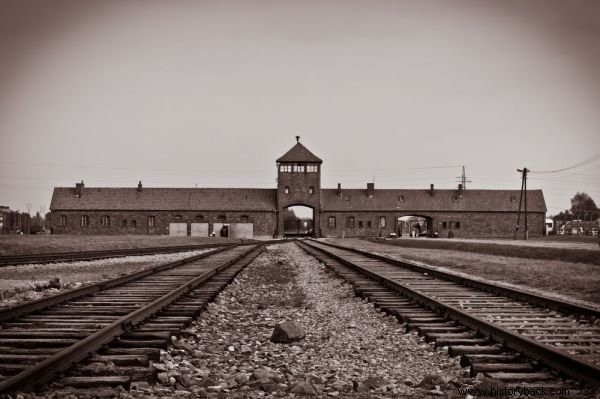The Auschwitz concentration and extermination camp was the largest prison camp in Nazi Germany and the largest center built to kill people in all of human history.
During World War II, 2.5 million people were executed for gas poisoning and another 500,000 died of disease and starvation.
Auschwitz was founded in May 1940 and operated until January 27, 1945, when Allied troops occupied the site and freed the prisoners.
Under the command of Rudolf Höss (1894 - 1947), the camp was the scene of the most well-known and intolerable Nazi atrocities, such as industrial-scale murders in gas chambers, torture, medical experiments and slave labor.
The concentration camp was installed near the city of Oswiecim, in Poland, about 60 kilometers from the capital Krakow. Very quickly, it became the biggest center of concentration and extermination of people in the Second World War.
 Railway that took prisoners directly to the concentration camp
Railway that took prisoners directly to the concentration camp
In addition to three major camps, Auschwitz comprised 45 more sub-camps. Auschwitz I was the main camp, where the clinics for medical experiments, torture and execution chambers were located.
The entry displays the ironic phrase, "Arbeit Macht Frei ", which means "Work Sets You Free". By the time of its liberation, Auschwitz had grown to include three major camps and 45 sub-camps.
Birkenau
The Auschwitz II camp site, also called Birkenau, was delivered in early 1942 and was located about 3 kilometers from Auschwitz I.
Birkenau was the stage for selections promoted by Nazi doctors upon arrival at the camp, at the place known as the ramp. Also in this place were most of the prisoners and there was an area destined for women and gypsies.
Camp Auschwitz III, still called Monowitz, was the destination of those who would be subjected to slave labor, as well as the 45 sub-camps of the complex.
Arrival and Selection
The transport of prisoners to Auschwitz took place on cattle freight trains. The mass of prisoners was formed by Jews, gypsies, homosexuals and other disaffected with the Nazi regime. Upon arrival, they were looted. Their goods remained in the wagons and formed part of a queue where they would be separated between fit and unfit for work by Nazi doctors.
In general, pregnant women, children, the disabled and the elderly were sent directly to the gas chamber. The rest would be driven to forced labor or fearful medical experiments. Each of Auschwitz's four extermination chambers had the capacity to execute 2,000 people.
Victims were told that they would undergo a disinfection process, where they would get rid of lice. Therefore, they voluntarily entered the chambers.
After the gas asphyxiation process, the victims' bodies underwent another looting. This time, teams of prisoners were forced to remove wedding rings, jewelry, and gold teeth from dead bodies. The belongings were sent to Germany and the bodies taken to the crematoria complex. The Auschwitz gas chambers operated between 1941 and 1944.
To complete your search, read also:
- Nazi Concentration Camps
- Holocaust
- Nazism
The Liberation
When the Soviet arrived at the camp, in order to free the approximately 7 or 8 thousand people prisoners, they encountered a lot of resistance from the Nazi army, the SS – guard of Adolf Hitler and several Soviets died.
Before, and with the approach of the Soviets, the Nazi army had started to destroy the gas chambers in order to eliminate the traces of terror in that place and to evacuate about 60 thousand prisoners. Forced to walk for kilometers, in the well-known “death march” , about 15,000 prisoners died.
In Brazil
Josef Mengele , the cruel concentration camp doctor known as “Angel of Death” , did research using people as guinea pigs, especially twins, dwarfs and pregnant women. After the research, the people who survived were sent to the gas chamber or hanged. He fled to Brazil where he lived in hiding until he died in 1979.
International Holocaust Remembrance Day
In 2015 , year in which the liberation of the camp completed 70 years , the fact was remembered by the world. The 300 people still alive who lived through the terror returned to Poland in a ceremony that testified to their suffering.
Museum
Currently, on the same site, there is a museum and a memorial, considered by Unesco as a heritage of humanity , where you can visit the facilities of the death camp, which maintains its architecture. Visitors have access to the rooms, the toilets (holes made in the floor), the place where the prisoner's number was engraved on each person's arm, and they can also see the personal belongings that the prisoners handed over when they arrived at the concentration camp:glasses, bags, brushes, photos, among others.
Books
There are several books that tell the story of Auschwitz, such as “Auschwitz - The Testimony of a Physician” , by Miklos Nyisli , one of the most well-known and shocking in the history of the Holocaust. This is an account of the doctor, Dr. Miklos Nyisli who worked in the concentration camp under the supervision of doctor Josef Mengele.
